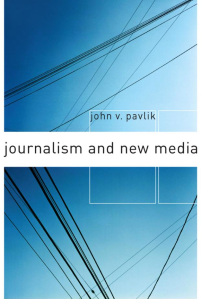New media, also known as social media, has revolutionized how we communicate. These changes have also spread to our professional communicators – journalists.
In 1980 CNN made history for being the first 24-hour news station. Today, we get our news in real time via social media sites like Twitter and Facebook. While we may have grown up getting our news from the nightly anchor or stories in the morning paper written by reporters, today we are getting it from journalists as well as bloggers, friends, family, organizations and even corporations that we follow online. Here are 10 ways journalism has changed just in the last decade.
In the late 1990’s, more and more newspapers created online versions as more and more of us were accessing the internet from home. In 2001, verteran of the journalism industry, John Pavlik wrote a guide for journalists and the public to help them navigate the rough waters of a new age. Years before the height of most social media, Pavlik’s book Journalism and New Media explores new technology and its potential for the news, and asks the pivotal question – will it better journalism?
Pavlik is an author and professor of journalism. He has served as the chair of the editorial board for Television Quarterly, the journal of the National Academy of Television Arts and Sciences, as a professor and the executive director of the Center for New Media at the Columbia University Graduate School of Journalism and as founding director of the School of Communication at San Diego State University. Today, he is a professor in the Department of Journalism and Media Studies at the School of Communication and Information at Rutgers University in New Jersey.
This week as we start our exploration of online and social media we hear from Pavlik and discuss whether or not his predictions in Journalism and New Media have come true in the years since it was first published. We also get his thoughts on social media, citizen journalism, and the next challenges for the news industry. We welcome his insight.
– – –
What have been the challenges for journalism to adapt to new social media resources?
As practiced in most of the United States since at least the era of the Penny Press of the Colonial period, journalism has been largely a one-way process of communication, from the journalist and her or his news organization to the public. Letters to the editor or other forms of feedback have been a small part of the process of public engagement and interaction. The rise of the Internet and the emergence of social media have challenged journalism as it has been traditionally practiced to become much more inclusive of contributions from the public and a dialog between journalists and members of the public, namely in the form of social media and mobile media. Citizens and other members of the public have demonstrated they have a strong inclination to share photos, video and text messages via social media, sometimes including news and other journalism-related content and commentary. Whether journalism has embraced this development, the public has become highly engaged in a lively social media discourse, often about or including news and news-related content. This has sometimes been difficult for journalism to accept or accommodate, as it often has meant a reduction in the control that traditional news media have over the news agenda.
Your book Journalism and New Media was written in 2001. One of the main arguments in it is that new media can revitalize news gathering and reengage a distrustful and alienated citizenry. This was before the creation and height of many of the social media resources most of us now use. With the rise of more social media options, have your thoughts changed or been confirmed over the years?
New media still present the potential to reengage the public. In many ways, in fact, social media and mobile media have led to a public that is often highly engaged in matters of public importance and the news. In the Arab Spring, for instance, members of the public often used mobile and social media to share photos, video and text messages about developments. From Egypt to Tunisia, Bahrain to Syria, citizen journalists were often the most frequent source of news and information.
Traditional news media and journalists have sometimes been reluctant to embrace social media, mobile media and citizen journalism or citizen reporting. Of course, sometimes citizen reporting can prove unreliable, and that is a serious concern. But, it can also be a vital part of journalism in an age of networked citizens.
With the advancements in social media, we have seen the rise of the citizen journalist. Do you think citizen journalism dilutes the industry or benefits it? Why?
I think citizen journalists, or citizen reporters, complement the role of the professional journalist. Many professional news organizations have dramatically cut their staffs, especially foreign bureaus in recent years. Consequently, many professional news media have far fewer resources to cover many stories and breaking news around the world. Citizen journalists or citizen reporters can help to fill in the gaps. I often use the term citizen reporter because in many cases to describe members of the public as journalists is inaccurate or overstating their role. Members of the public often lack the training to operate as a journalist. But, equipped with a mobile device connected to a network, a citizen can act as a reporter, documenting news as it happens, taking photos or shooting video and sharing it with a wider community. With literally billions of citizens around the world equipped with network-enabled digital mobile devices (e.g., smart phones, tablets), the public today can operate as an extraordinary news gathering force. Oxford’s Bill Dutton calls the public in this role the Fifth Estate (complementary to the professional journalist as Fourth Estate).
In Journalism and New Media you also acknowledge that new media presents many threats to the values and standards of journalism? Which values and standards are the most at risk? How do we protect them in today’s digital world?
One of the greatest threats developments in new media raise is the pressure to produce news and commentary in real-time and on a continuous basis. This has contributed to problems in accuracy (i.e., errors) and fact-checking. The problem has been exacerbated by reductions in staff and other resources for news media, as they have struggled to develop vibrant new business or funding models to sustain robust journalism in the 21st century.
Another problem fueled by digital developments lies at the nexus of freedom or speech, or the public’s right to know, and the public’s right to privacy. Digital developments have led to a dramatic increase in surveillance and tracking of citizens, whether by governments, media or others. Governments have also sought to restrict journalistic enterprises, especially their sources. Striking a balance between the First and Fourth Amendment may be one of the greatest challenges of the digital age.
On the positive side, what do you think are some of the best social media sites for news reporting?
For many members of the public, especially in the U.S., Facebook and Twitter have emerged as important social media sources of news and information, whether from friends, family or professional news media. One of the less-well-known social media that plays an interesting role from a journalism perspective is Storify. A look at Storify on 27 February 2014 at 6pm EST shows a series of interesting stories. Among the more notable news-related items are protests in Venezuela, smog in Beijing, and social media reactions to Arizona’s SB 1062 veto.
Instagram and Snapchat are also social media worth considering in the future of journalism mix, as they are especially popular among youth who use them relentlessly to share photos and sometimes news.
Who are some of the journalists or media organizations that you see as examples of maintaining standards on new media the best?
Among the traditional news media, certainly The New York Times does a superb job of maintaining standards with regard to using new media. From video to augmented reality, the Times has engaged the public effectively with emerging new media. Internationally, TheGuardian.com has been impressive in its blending of quality traditional news values with the unique capabilities afforded in the digital, networked age. In addition to breaking the NSA secret surveillance story, TheGuardian.com has used data-driven reporting highly effectively. One of its most important investigations involved an algorithm-based analysis of Twitter posts to help tell the story of the Tottenham Riots.
Less well-known is ProPublica, a digital news venture that has established standards of excellence in journalism, particularly in data-driven reporting.
Online and social media allow breaking news to be shared instantly. Being the first to break a story is a prized position. However, the rush to be first to cover a story could comprise journalism standards. What is your advice to the reader about evaluating news when it first breaks?
My advice to all citizens is to never rely on a single source for news and never automatically accept what you see, hear or otherwise experience in the media. Always maintain a critical perspective and check multiple, diverse sources on any important news.
What advice do you have for aspiring journalists in the digital age?
Today is a time for innovation. Digital, networked technologies have generated a wealth of opportunities to enable aspiring journalists to create new, reliable and ethical methods of reporting, storytelling and public engagement, and to potentially bring those innovations to the world at large. Bring your ideas forward in a way that advances vigorous journalism, supports the First Amendment, and respects individual privacy. Remember the words of Mr. Dooley: Newspapers should comfort the afflicted, and afflict the comfortable.
If you have an idea for doing quality journalism in a new way, explore crowd funding online resources and see what you might be able to do to get support for your creative idea.
What do you foresee being next challenge and possible solutions the journalism industry will face?
One of the most vexing challenges for traditional journalism organizations is to develop viable funding mechanisms to support quality news gathering, storytelling and public engagement. Digital, networked technologies, especially mobile media, point the way to that future. The question is whether traditional news media industry leadership will be bold enough to pursue that future with vigor and not let risk aversion drag the news industry into irrelevancy and obsolescence or a specialized service for only the elite who are able to pay the high-price of quality journalism.
A near-term opportunity is to build innovative strategies for using mobile, wearable and other emerging technologies (e.g., drones, algorithms, Big Data) as well as social media to re-invent journalism. The challenge is to transform journalism from the long-standing one-to-many paradigm to a many-to-many paradigm where interacting with the public isn’t what happens after news has been reported but is a continuous and fundamental part of an ongoing process of engaged journalism.
– – –
We look forward to watching the 4th Estate continue to evolve in the digital age. What ways to do you think journalism can use new media to save itself?
Liz Faris, Account Manager
Collaborative Services






Recent Comments